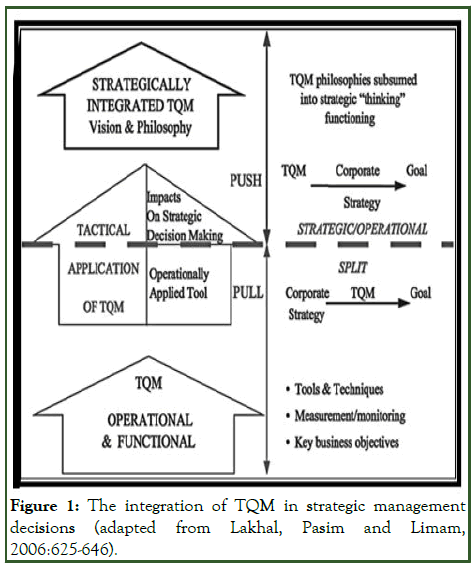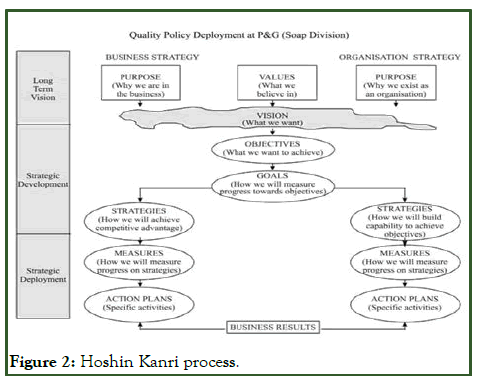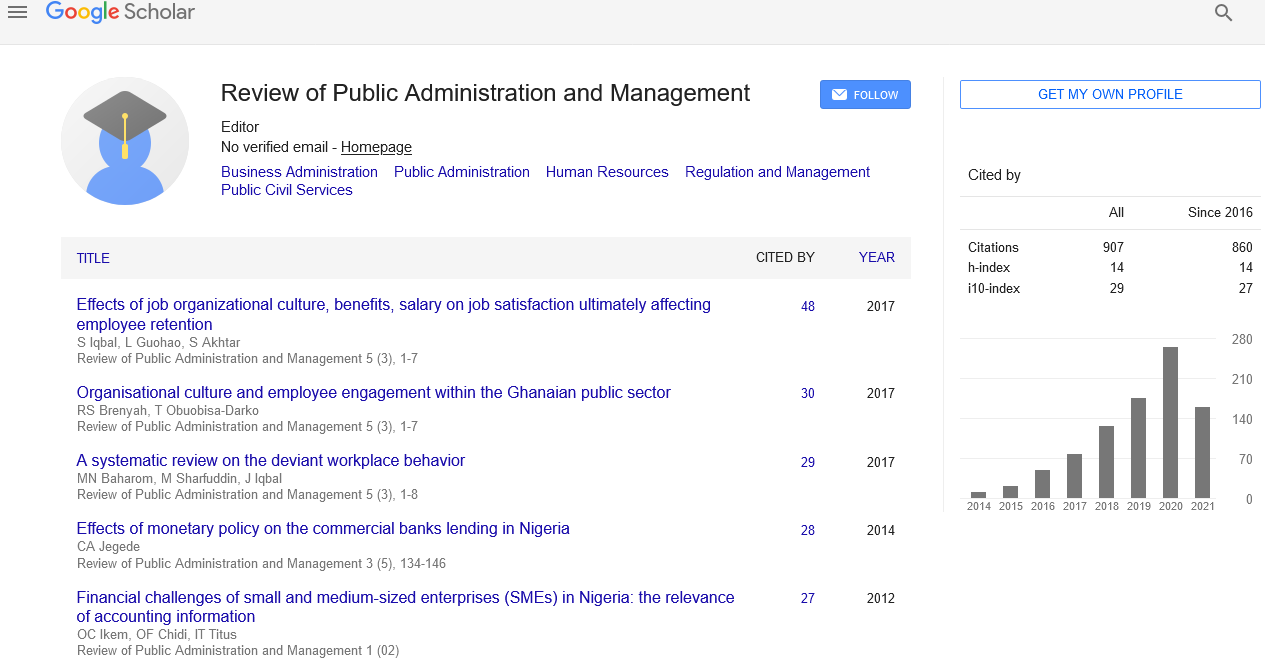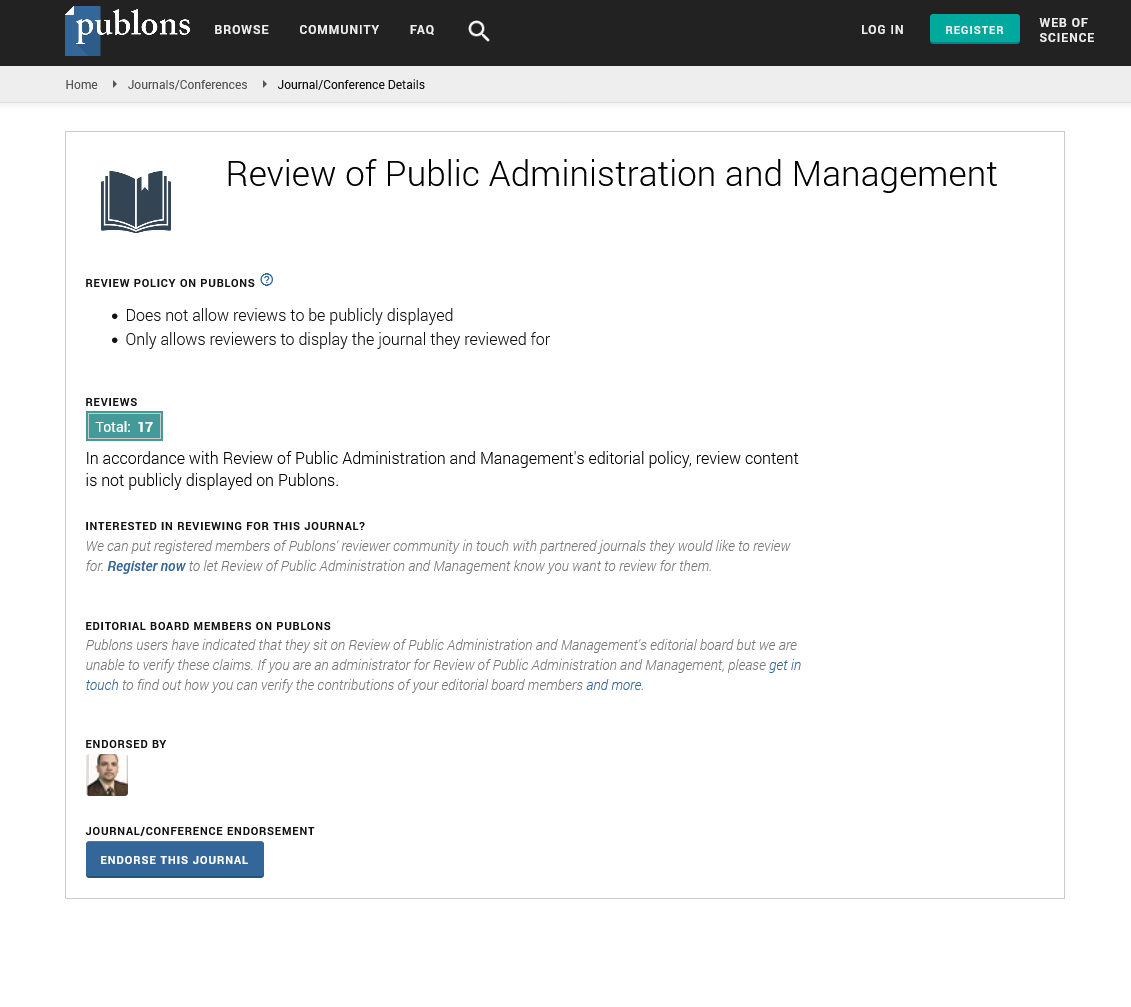Indexed In
- CiteFactor
- RefSeek
- Directory of Research Journal Indexing (DRJI)
- Hamdard University
- EBSCO A-Z
- Scholarsteer
- Publons
- Euro Pub
- Google Scholar
Useful Links
Share This Page
Journal Flyer

Open Access Journals
- Agri and Aquaculture
- Biochemistry
- Bioinformatics & Systems Biology
- Business & Management
- Chemistry
- Clinical Sciences
- Engineering
- Food & Nutrition
- General Science
- Genetics & Molecular Biology
- Immunology & Microbiology
- Medical Sciences
- Neuroscience & Psychology
- Nursing & Health Care
- Pharmaceutical Sciences
Research Article - (2024) Volume 12, Issue 4
The Importance of Integrating Quality Practices in to Strategic Management
Baldada Kepa*Received: 12-Nov-2020, Manuscript No. RPAM-20-7128; Editor assigned: 17-Nov-2020, Pre QC No. RPAM-20-7128 (PQ); Reviewed: 01-Dec-2020, QC No. RPAM-20-7128; Revised: 15-Jul-2024, Manuscript No. RPAM-20-7128 (R); Published: 12-Aug-2024, DOI: 10.35248/2315-7844.24.12.468
Abstract
Several organizations fail because they do not take cognizance of the long term benefits of quality practices. They do not realize the value of integrating these quality practices into their routine operations. Hence, this study would endeavor to highlight the usefulness of incorporating quality practices in an organization’s strategic management process.
According to Kevan Williams, strategy is about creating and delivering the future. It is about leading your team or your organization to a future in which you are able to compete more effectively and to achieve prosperity and sustainability. The skills of strategic management are applicable to those leading a team or planning the direction of any size of organization in all sectors private, public and voluntary.
Strategic management has become one of the core functions of organizations. Lumpkin and Taylor revealed that in order for organizations to be competitive and sustainable in the long term, they need to have a clear understanding of their goals and strategies. They believe that this can be achieved by using strategic management as a tool and that it provides a means for organizations to coordinate their functions and resources to achieve prescribed strategies according to an environment in which the organization may find itself. In this way the organization can not only adapt to the changing environment, but can also gain a competitive advantage.
Keywords
Working capital management; Profitability; Turnover ratio; Investment
Introduction
Kevan Williams proposed that strategic management is for those taking or wanting to take, their first steps to developing and implementing strategic changes. It gives you the tools you need to make effective strategic decisions, by helping you analyze your organization and the world it operates in, plan your strategic approach and implement the changes [1]. It provides insight into how to gain a competitive advantage, which is at the heart of good strategy. In addition quality tools such as Hoshin Planning, ISO series, continuous improvement and the six sigma can be applied to solve problems and to improve quality within organizations. Brown states that not only should quality practices be linked with the strategic planning process but it should receive organization-wide commitment [2].
Statement of the problem
Lee stated that in 1980, the Chrysler corporation was close to bankruptcy. This was due to the quality problems experienced with their new fleet of cars. In 1990, under the supervision of a newly appointed vice president, Chrysler changed their strategic management style. The organization focused on their missions, goals and strategies to determine the root cause of their problems. One of the ways in which they overcome their problems was by evaluating their purpose in the motor industry [3]. Chrysler then developed a mission statement which introduced them as one of the premier automotive organizations based on their quality efforts. Almost half of their employees were involved in quality teams. But they experienced no change in results, in cost structure, customer satisfaction and in markets hare. It did not take long to discover that the root cause of their problems was that there was no real strategic or quality plan.
Furthermore, employees throughout the organization did not know which activities were important and did not prioritize urgent ones. The activities were not aligned with key strategies. Improvements w ere not linked to provide meaningful results across critical processes. Even at senior levels, they had no clear agreement on important priorities. However, new efforts were introduced later and they improved quality and have subsequently made Chrysler one of the top ten automotive organizations in the motor industry. Gale explains that in 2002, Toyota had experienced similar difficulties as Chrysler, with the quality of some of their cars. After redirecting their strategic goals, Toyota became a very successful organization throughout the world in terms of their quality and excellence.
Objectives of the study
General objectives: The aim of this study is to evaluate the importance of quality practices during an organization’s strategic planning process.
Specific objectives includes:
• To analyses the relationship between quality practices and
strategic management.
• To identify which quality practices are integrated in to
strategic management process.
• To develop an understanding of the use of quality practices
when it integrated in strategic management process.
• To show the alignment between the quality practices and
strategic management in textile industry.
Research hypothesis
Hypothesis can be defined as a logically inference relationship between two or more variables expressed in the form of a testable statement. Relationships are guessed on the basis of network relations established in the conceptual framework formulated for the research study [4]. In this particular study, independent variables (quality practices) are measured to see if it has any relationship with dependent variable (strategic management).
Main hypothesis: There is a significant integration between quality practices and strategic management in Ayka Addis textile and investment group.
H1: There is a strong integration between TQM and strategic management in Ayka Addis Textile and Investment Group.
H2: There is a significant integration between six sigma and strategic management in Ayka Addis textile and investment group.
Materials and Methods
The definition and evolution of strategic management
According to Grant the purpose of strategic management is to match an organization’s strategy, with the business environment that it is associated with. He also states that strategic management is a process by which an organization manages the formulation and implementation of its strategy. Carpenter and Sanders indicate that there were some criticisms of strategic management. They state that some critics claim that there is insufficient theoretical knowledge of strategic management to help managers make important decisions [5]. The complexities arise because the environment is permanently changing and effective strategic management requires a continuous flow of theories that suitable for new circumstances.
Advantages of strategic management
Aligning organizational goals and objectives: Hill and Jones define strategic management as the science of formulating, implementing and evaluating cross functional decisions which will enable an organization to achieve its objectives. It is a process of specifying the organization’s goals and objectives, with a view to developing policies and plans to achieve these goals and objectives. Venter pointed out that strategic management is an ongoing process that assesses the market in which the organization is involved, evaluates its competitors and then sets goals and strategies to meet all existing and potential customer needs. Hence, this idea indicates that successful organizations have the ways to ensure that their organizational goals and objectives are aligned with the organization’s mission to accomplish the strategies.
Gaining a competitive advantage: Calcagno and McCell believe that a competitive advantage is obtained as the result of an organization’s planned strategy. The strategic direction is realized for the organization to produce greater profits than their competitors. Many factors are equally important in producing a position of success.
The study of mechanisms responsible for creating a sustainable competitive advantage provides many interesting opportunities, to investigate the factors for the organization’s competitive success. Kelemen explains that strategic management is considered as a useful tool for gaining a competitive advantage. This competitive advantage enables organizations to survive against its competition in the long term. Vinzant and Vinzant are also in agreement with this opinion and express that it encourages managers to focus on plans to compete successfully and be sustainable in the market [6]. McCell claims that changes in local and international markets and increased competition have forced organizations to re-evaluate their competitive strategies.
Disadvantages of strategic management
The lack of a SWOT analysis in a rapidly changing environment: Madu, Aheto, Kuei and Winokur assert that in a competitive environment, quality is the key to an organization’s survival and success. It is clear in today’s turbulent environment that an organization’s survival depends on the ability to satisfy customers’ needs and wants and to compete in globally changing environments [7]. But, to compete effectively, the organization must respond to the dynamic changes in its internal and external environment.
The changes that occur in strategic plans: It can be inferred that changes in strategic plans can result in poor decision making and lack of proper strategic management procedures. Therefore there is an old adage which Mintzberg quotes “if you fail to plan, you are planning to fail”.
Several reasons can be investigated as to why strategic plans fail. Grant identifies some of the reasons why strategic management initiatives fail. These include the failure to understand the customer and the inability to predict environmental change.
Tang and Bauer are of the view that most organizations do not have explicit operational strategies even though the importance of these strategies are needed. Crowe and Cheng support Tang and Bauer opinion and elaborate that one of the most important reasons for the latter in the lack of a practical and powerful methodology or practice to translate corporate strategies that lead to overall organizational success [8].
Results and Discussion
Figure 1 indicates the usefulness of TQM philosophies within the strategic planning process.

Figure 1: The integration of TQM in strategic management decisions (adapted from Lakhal, Pasim and Limam, 2006:625-646).
Figure 2 shows the Hoshin Kanri planning process of procter and gamble soap division and illustrates how quality is deployed in their strategic management process. Hoshin Kanri acts as a management compass that steers everyone in the organization in the same direction, toward a common goal [9]. Therefore it can be concluded that the Hoshin Kanri system contributes to continuous improvement in strategic management.

Figure 2: Hoshin Kanri process.
Advantages of ISO 9001:2000 certification: The ISO 9001:2000 code of practice provides another quality tool which can be used in the strategic management process. Peter K., celaborates that ISO 9000 is a family of standards that defines the guiding principles of quality management, lists the certification requirements and provides guidelines on how to establish systems for managing procedures and product/service quality [10]. It aims to facilitate global trade and improve organizational effectiveness. Allen and Kilmann identify five key areas related to quality which can be included into the strategic management process:
• The development of a continuous improvement culture
throughout the organization and strategic integration.
• The deployment of quality practices in functional levels of the
organization.
• Customer focused strategic planning.
• Most effective competitive strategy for sustaining
organizational performance planning.
• Gaining a strategic advantage.
• A level of priority given to continuous improvement.
The lack of total quality management initiatives
Chin and Pun claim that there is a strong perception that quality practices and strategic planning have a direct relationship with increased organizational performance. However, the latter is difficult to achieve without the development and implementation of a TQM philosophy.
Hasmi states that although TQM recommends continuous impr ovement as a tool for increasing customer satisfaction, many organizations have overlooked including it when developing relevant strategies [11]. It should be recognized that although most. The Table 1 below shows some of the key differences between six sigma and TQM:
| Six sigma | Total quality |
|---|---|
| Executive ownership | Self-directed work teams |
| Business-strategy execution system | Quality initiative |
| Cross-functional | Largely within a single function |
| Focused training with verifiable | No mass training in statistics and return quality |
| Business results oriented | Return on investment |
| Reduced defects | Quality oriented |
Table 1: Differences between six sigma and TQM.
The second criticism is that it has little to offer that cannot be found elsewhere. It is true, that six sigma programs have incorporated tools that have been useful in previous.
This study is intended to carry out at Ayka Addis textile and investment group. The study was designed as the cross-sectional survey for the quantitative study which is used togather the relevant and pertinent information with regard to incorporating quality practices in to strategic management process. Thus, this study is classified as a survey research.
Research design
The purpose of this study is to evaluate the usefulness of integrating quality practices in strategic management process. The study is said to be co relational in design because there is the intent to establish the relationship between dependent and independent variable of the study. According to Reid, corelational research aims to ascertain if there is a significant association between two variables. The nature of this research is to identify if there is a relation between the predictor variable and the response variable [12]. The predictor variable is quality practices, and the response variable is strategic management.
Creswell asserted, “By explaining a relationship among variables, you are interested in determining whether one or more variables might influence another variable.
Validity and reliability test
Construct validity-in this study the researcher tried to address the construct validity through the review of literature and adapting instruments used in previous research. Furthermore, the research addresses through defining clearly the construct of interest and develop valid measures that operationalise defined constructs as well as pilot study.
Statistical conclusion validity: In quantitative and qualitative type of study it is worth to consider the issue of statistical conclusion validity. This type of validity is addressed through selection of the correct statistical method used for hypothesis testing. Hence, the appropriate statistical testing is both Pearson correlation for interval scale variable and regression analysis for interval scale variable is selected by researcher so that the conclusion derived using this statistical procedure is valid (Table 2).
| S/n | Variables of the study | No of items | Cron bach alpha value |
|---|---|---|---|
| 1 | Total quality management | 8 | 0.745 |
| 2 | Six sigma | 10 | 0.801 |
| 3 | Hoshin planning | 6 | 0.78 |
| 4 | Strategic quality management | 6 | 0.784 |
| 5 | ISO 9001:2000 | 6 | 0.76 |
| 6 | Strategic management | 7 | 0.726 |
| 7 | Over all combined variables | 43 | 0.957 |
Table 2: Alpha coefficient for independent and dependent variables and the combined variables.
Conclusion
In a fast moving, a rapidly changing environment, an organization continues to set goals and objectives and formulate strategies to achieve them. However, due to the constantly changing industry and competition, further action needs to be implemented. Therefore, it has been identified that there is a need for an intervention like the integration of quality practices into the strategic planning process.
Ethical Consideration
Before writing the thesis, the researcher considered the ethical issues that can be anticipated and described in the study. These issues relate to all phases of the research process. The problem identified by the researcher benefits individuals being studied and that will be meaningful for others. The researcher was not further marginalize or disempowered the study participants; and restricts claims about groups to which the results can’t be generalized. The purpose of the study was described to the participants and it was provided letter of approval in order to establish trust and credibility.
Limitations of the Study
Though the study presents a comprehensive theme over the preceding and succeeding chapters, it is not free from limitations. As a result, this study was conducted with some sort of limitations. The researcher would face with many problems which, in fact, may affect the quality of the study. There was a confront in conducting a study due to a limited time frame and the limited access information; when the researcher inquires respondents they were hesitating of the purpose of the study and show the sort of reluctant to offer the correct information.
Recommendations
In this study, overall correlation and regression analysis gave positive results. Consequently, industry must take these variables i.e., quality practices and strategic management simultaneously if they want better results and improved Productivity in their industry. In this research it has taken five dimensions of quality practices to understand the usefulness when it’s integrated in strategic management.
References
- Allen RS, Kilmann RH. The role of the reward system for a total quality management based strategy. J Organ Change Manag. 2001;14(2):110-131.
- Aravindan P, Devadasan SR, Selladurai V. A focused system model for strategic quality management. Int J Qual Reliab Manag. 1996;13(8):79-96.
- Bossink BA. Innovative quality management practices in the Dutch construction industry. Int J Qual Reliab Manag. 2002;19(2):170-186.
- Brown P. The evolving role of strategic management development. J Manag Dev. 2005;24(3):209-222.
- Maria R. Calingo L. The evolution of strategic quality management. Int J Qual Relia Manag. 1996;13(9):19-37.
- Chin KS, Tummala VR, Chan KM. Quality management practices based on seven core elements in Hong Kong manufacturing industries. Technovation. 2002;22(4):213-230.
- Chin KS, Pun KF. A proposed framework for implementing TQM in Chinese organizations. Int J Qual Reliab Manag. 2002;19(3):272-294.
- Cronbach LJ. Coefficient alpha and the internal structure of tests. Psychometry. 1951;16(3):297-334.
- Crowe TJ, Cheng CC. Using quality function deployment in manufacturing strategic planning. Int J Oper Prod Manag. 1996;16(4):35-48.
- Friday‐Stroud SS, Sutterfield JS. A conceptual framework for integrating six‐sigma and strategic management methodologies to quantify decision making. The TQM Magazine. 2007;19(6):561-571.
- Ginter PM, White DD. A social learning approach to strategic management: Toward a theoretical foundation. Acad Manag Rev. 1982;7(2):253-261.
- Kuwada K. Strategic learning: The continuous side of discontinuous strategic change. Organ Sci. 1998;9(6):719-736.
Citation: Kepa B (2024) The Importance of Integrating Quality Practices in to Strategic Management. Review Pub Administration Manag. 12:468.
Copyright: © 2024 Kepa B. This is an open-access article distributed under the terms of the Creative Commons Attribution License, which permits unrestricted use, distribution, and reproduction in any medium, provided the original author and source are credited.


